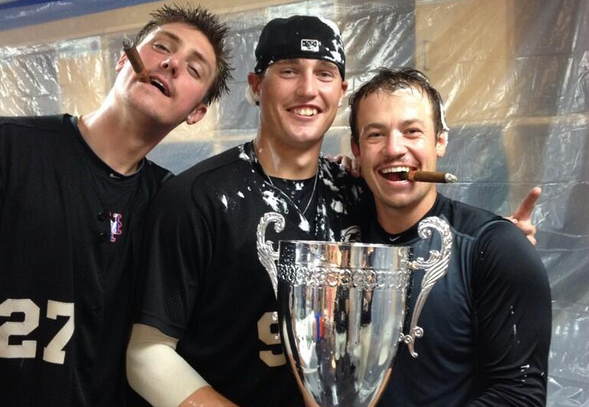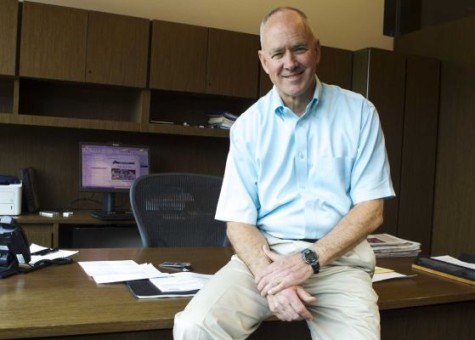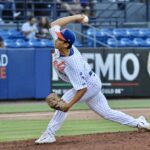
When Sandy Alderson was hired by the Mets as their new GM in 2010 there was a flurry of conjecture about what sort of effect he would have on the team. Words like “Moneyball with money” were being thrown around by Paul DePodesta and J.P. Ricciardi, and everyone started speculating about what exactly this new version of moneyball would look like. Would it be high OBP guys like in Oakland? Would it be right-handed pitchers with durability profiles? Would it be defense up the middle and power from unlikely sources? Would it be outfielders with allergies to cat dander?
Since that time, most of us have settled into the realization that Alderson and his brain brigade didn’t really unveil anything unique in their approach to player acquisition. With the exception of a tendency towards high schoolers with good eyes at the plate (an eye for an eye!), there was little to satiate the masses who were waiting impatiently for Moneyball 2.0. It never materialized.
What I think many of us failed to appreciate, however, was that exploiting market inefficiencies was nothing new in MLB. Ever since the 90’s when Oakland managed to piece together a winning amalgamate from overlooked and undervalued spare parts, teams all across the league hired numbers-crunchers in an attempt to find other players possessing favorable and overlooked competitive adaptations. Funny thing is that with the exception of OBP, not much else had been overlooked … Oh sure, some teams went after character guys while others tried to secure command and control pitching while still other teams went for power arms, but that had all been done before in the hundred-plus year history of the game.
But there was definitely something different at work with these guys. Sandy DePo and Ricciardi are not the sort to sit back and follow tried and true paradigms. They were advertised as innovators and the more I observed their often secretive machinations (especially on the part of DePodesta who I imagine still lives in his underground numbers bunker deep beneath Citi Field, coming out every few days to test new Frisbee designs and shake hands with his children), the more I felt they were up to something, I was certain of it.
I don’t think DePo would have been coy and evasive early on when questioned about what sort of organizational innovations he had in store if he wasn’t actually hiding something. He openly stated that he wouldn’t share his angle even if he had one … but the way he said it made me wonder.
Now I’m a words guy, language is my thing … I pride myself on my ability to read between the lines and derive whatever hidden connotation an inconspicuous comment may yield. The phrase that stood out for me when Collins first hit the scene was “muscle memory.” I swear that first spring I remember at least 4 or 5 players using the term “muscle memory” during interviews. That smacked heavily of an organizational initiative, a mantra.
At the same time Sandy Alderson was spouting loquacious on his desire to streamline the organization from top to bottom with an emphasis on adapting every level to a uniform set of principles. A complete overhaul of our player development program.
Lots of GM’s try to leave their mark by establishing a distinct organizational ethos … nothing new about that right? Only Sandy Alderson and his minions referred to this organizational cohesion as if it were the thing. Almost as if cohesion of purpose across levels was in fact their angle, as if it was the innovation that would somehow create that elusive “unfair advantage.” No, it couldn’t be, I thought. How boring would that be? The organizational stuff is simply a byproduct of Sandy’s military days. He knows how important uniformity and cohesion are for any successful organization … there had to be something else.

But as the years progressed this mantra persisted, and the minors saw a distinct resurgence with more wins from more of our minor league affiliates, fueled by the persistent drone of the same principles across every level. Muscle memory over and over and over.
Then there were the drafts … one high school player after another. Over and over the Mets drafted teenagers who were years and years away.
When you put all this together I think what you have is something akin to our
“new moneyball.” The Mets have designed what they feel is a system that will take raw youngsters with the right physical and intellectual temperaments and graduate them successfully to the majors by means of immersion in a uniform set of principles that they believe will give them a competitive advantage. Those principles of course involve getting on base, plate discipline, attacking the zone, all invoked with thousands of hours of mind numbing repetition.
Now it is certainly true that with younger players you have greater control over whatever developmental trajectory they happen to be on. Older players are what they are, they don’t have much time to put it all together before their bodies hit their physical prime years of 27, 28, and 29 (and for some reason 31) … With a high school player you have 8 to 10 years to make sure they get the reps they need before they hit their physical prime … which comes out to right around 10,000 hours of “practice.” With college players you have about half that time.
And that’s where the innovation comes in. The notion that talent isn’t some magical gift bestowed upon us by the gods or heredity, that given comparable physical attributes the more “talented” individual is almost always the one with the most hours of practice.
As Malcolm Gladwell in his groundbreaking book Outliers pointed out, the 10,000 hour rule is the single greatest predictor of “elite” performance, whether it’s playing a violin or striking out major league batters. On the Mets, “muscle memory” has become a catch phrase for expert status, and it takes 10,000 hours of practice (around 10 years) to achieve elite performance levels. It is a remarkable predictor with the highest levels of performance coming at right around the 10,000 hour mark across a wide variety of disciplines.
What Alderson and his assistants are attempting is a shift away from a scouting/talent paradigm to a tools/development paradigm … and Brandon Nimmo is their poster child. Now I’m not saying they’re actively seeking out blank-slate 18-year olds with solid physical attributes and little else. Naturally you’re going to draft the more talented player when available. But I think what’s interesting is the notion that the Mets might be inclined to draft a raw but physically gifted younger player over a perhaps more “talented” older player because by acquiring the younger player they control the trajectory and the progress, while “talent” at lower levels doesn’t always translate to higher levels.
The approach reminds me a little of the rifle range in boot camp. Our instructors loved guys who’d never fired a weapon because although they were raw, they didn’t have any bad habits, they were able to train us the correct way. I’d never touched a firearm in my life yet I shot high expert my very first try. Similarly this Met front office believes they are more likely to succeed by promoting a system that will produce elite performers from the scratch of raw physical aptitude rather than relying on occasionally finding the lightning in a bottle that is what we sometimes describe as “a natural.”
In the end the proof is in the pudding as they say, and the first batch of this particular confection will hit the stage late next summer barring some cataclysmic barrage of injuries or misfortune. It will be immensely interesting to see whether it was all worth the wait.















